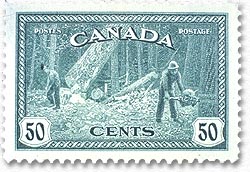

Workers in another major staple trade appear in a 1946 stamp (#272) promoting the modern lumber industry. Again, mechanization of production is a central theme. Here we see two workers, equipped with the "power-saws" or "chain-saws" of the 1940s, engaged in the new mechanized method of felling trees. Notice that both men seem to be working with their backs to a falling tree. In light of the hazardous scene depicted here, this stamp provoked some controversy when it was issued and has sometimes been called "the reckless lumberman" stamp. Apparently the stamp design was based on two separate photographs from the British Columbia woods, combined here for artistic effect in what might be considered an early instance of magic realism. "In actual practice two 'sets' of fallers would not work so close together," observed one commentator, "and the inclusion of the two sets in the design has been done to make a more pleasing oblong-shaped stamp."18 A more heroic depiction of a lumber worker appeared in Henry Holgate's portrait, "The Lumberjack"; this was included among the stamps issued in 1995 (#1561c) in honour of the Group of Seven; the stamp, like Holgate's paintings themselves, can be considered as part of an effort to compensate for the lack of human figures in the landscapes of that school.19
Canada Scott 272
Stamp reproduced courtesy of Canada Post Corporation
|
 |
The first Canadian stamp to make reference to the miners was issued in 1957 (#373). It shows an underground worker operating a cutting machine at the face. This is a severe black and white image that underlines the stark setting of underground work. Although the stamp was issued on the occasion of a Commonwealth Mining and Metallurgical Congress, many Canadians may well have taken it as a tribute to the miners at Springhill, Nova Scotia, where 39 men had been killed a year earlier and 75 more would be killed the following year. There is an evocation of an earlier mining industry in 1958, on the 100th anniversary of British Columbia, in the image of a miner panning for gold (#377). A later stamp in 1978 (#765) showed men at work at a Cobalt silver mine. The gold mining operations at Yellowknife are represented in a 1984 stamp (#1009) that excludes any reference to work process or labour relations. There have been no stamps commemorating mine disasters or other catastrophes such as the sinking of the Ocean Ranger; such themes appear to contradict the official narrative of Canadian development.20
|



